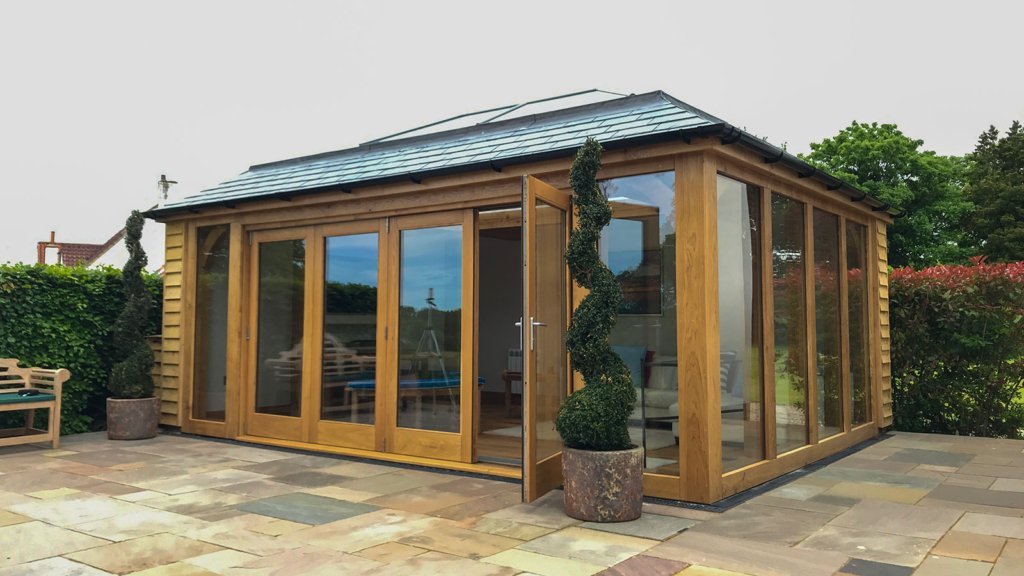
oakbydesign
01423 593 794



Are you dreaming of a beautiful oak conservatory that seamlessly blends with your home and adds a touch of elegance to your lifestyle? Look no further!
In this article, we will guide you through the process of designing your own and how it connects with your home.. From understanding planning permission requirements to considering cost and design options, we’ve got you covered.
Get ready to create a space that not only enhances your home but also brings you joy for years to come.
Are you wondering about the planning permission requirements for oak conservatories? Understanding the regulations and guidelines can help you ensure that your project meets all the necessary criteria.
Planning consent is typically required for oak buildings, but there may be instances where you can take advantage of permitted development rights.
It’s important to familiarise yourself with the specific rules and limitations in your area to avoid any potential issues during the construction process.
You’ll need to consider planning consent before constructing your oak conservatory. Planning permission requirements for oak conservatories may vary depending on your location, home design and the specific regulations set by your local planning authority.
Generally, if your oak building meets certain criteria, such as being within permitted development rights, you may not need planning permission. However, it’s always recommended to check with your local planning authority to ensure compliance.
Factors that may affect planning consent include the size, height, and how it is situated against your home. as well as whether it’s considered an extension or a separate structure.
Keep in mind that oak conservatory kits or oak frame conservatories may have different planning requirements compared to other types of oak buildings or oak frame buildings.
It’s advisable to consult a professional to determine the necessary planning consent and to estimate the potential impact on the conservatory cost.
You can determine if your oak building falls under permitted development by checking the specific regulations set by your local planning authority. Permitted development allows you to make certain changes to your property without the need for planning permission. However, it’s important to remember that each local planning authority may have different regulations, so it’s crucial to consult with them before proceeding.
When it comes to oak conservatories, the use of air-dried oak can be a significant factor in determining whether it falls under permitted development. Air-dried oak is a popular choice for conservatories due to its durability and attractive appearance. It’s important to ensure that the use of air-dried oak in your conservatory complies with local regulations to avoid any potential issues with planning permission.
When it comes to designing an oak building against your home, there are various design options to consider.
From the shape and size of the conservatory to the type of glazing and roofing materials, each decision will contribute to the overall look and functionality of the space.
Choosing Air-dried or seasoned oak over green oak will give you a huge advantage when it comes to glazing!
Additionally, cost factors such as materials, labor, and any additional features or customisation will need to be taken into account to ensure that the design aligns with your budget.
An oak conservatory offers a range of design options that can fit both your budget and desired aesthetic. When designing your perfect addition, there are several factors to consider, including cost and design considerations.
First, determine the size and shape of your conservatory. This will depend on your available space and how you plan to use the area.
Next, consider the type of roof you want, whether it’s a glass roof for maximum natural light or a tiled roof for a more traditional look.
Additionally, think about the doors and windows. Choose between bi-fold doors, French doors, or sliding doors, depending on your preferences.
Lastly, consider the interior design elements, such as flooring, lighting, and heating options.
Consider the size and materials of your extension, as well as the complexity of the design, to determine the overall cost.
Today, the size of your conservatory will have a significant impact on the cost, as larger structures require more materials and labor.
Additionally, the materials used can greatly affect the price. Oak is a premium material, known for its durability and beauty, but it comes at a higher cost compared to other options.
The complexity of the design is another factor to consider. Intricate designs with unique features or customisations will require more time and expertise to build, resulting in a higher cost.
It’s important to carefully consider these factors when planning your dream extension to ensure it aligns with your budget.
You should contact multiple suppliers to get quotes for the construction of your oak building. This will help you compare prices and choose the one that fits your budget. When selecting suppliers, make sure to consider their reputation, experience, and the quality of their materials. It’s important to work with a reputable supplier who’s a proven track record in their construction.
Once you have chosen a supplier, you can move on to the construction phase. It’s advisable to hire a professional contractor who specialises in solid oak projects. They’ll have the necessary expertise and knowledge to ensure that your conservatory is built to the highest standards.
Before construction begins, it’s important to obtain any necessary permits or approvals from your local authorities. This will ensure that your building complies with all building regulations and codes.
During construction, it’s important to regularly communicate with your contractor to ensure that the project is progressing as planned. Regular site visits will allow you to monitor the progress and address any concerns or issues that may arise.
Once construction is complete, make sure to conduct a thorough inspection of the conservatory to ensure that everything is in order. This will help identify any potential issues that need to be addressed before they become major problems.
When it comes to choosing the glazing, there are several options available to consider.
From double glazing to triple glazing, each option has its own benefits in terms of insulation and energy efficiency.
Additionally, it’s important to be aware of the building regulations that govern the use of glazing in conservatories, ensuring that you comply with safety and structural requirements.
To ensure compliance with building regulations, it’s important to understand the different glazing options available for your oak conservatory. The type of glazing you choose won’t only affect the overall aesthetic of your conservatory but also its thermal performance and energy efficiency.
There are several glazing types to consider, including single glazing, double glazing, and triple glazing. Single glazing consists of a single pane of glass and is the most basic option.
Double glazing, on the other hand, consists of two panes of glass with a gap in between, providing better insulation. Triple glazing offers even higher insulation properties with three panes of glass and two gaps.
When choosing the glazing type for your oak conservatory, it’s important to consider factors such as your budget, desired level of insulation, and local building regulations.
To ensure compliance with building regulations, consider the glazing options available for your frame conservatory. Building regulations dictate specific requirements for glazing in order to ensure safety and energy efficiency.
When it comes to glazing options, you have a few choices to consider. Double glazing is a popular choice as it provides better insulation and noise reduction. It consists of two glass panes with a layer of air or gas in between.
Another option is triple glazing, which offers even higher insulation properties and soundproofing.
Laminated glass is recommended for safety purposes as it holds together when broken, reducing the risk of injury.
Finally, toughened glass is a durable option that’s resistant to impact and breakage.
Consider these glazing options to meet building regulations and create a safe and efficient oak structures.
You’ll appreciate the durability of oak conservatories due to their low maintenance requirements and long lifespan. Oak is a hardwood that’s known for its strength and ability to withstand the elements. Unlike other materials, oak conservatories require minimal upkeep, making them a practical choice for homeowners.
One of the main benefits of ‘oak framed’ extensions are their low maintenance requirements. Oak is naturally resistant to rot and insect damage, reducing the need for regular treatments or repairs. Simply cleaning the conservatory periodically with a mild soap and water solution is usually sufficient to keep it looking its best.
In addition to being low maintenance, oak conservatories have a long lifespan. When properly cared for, an oak conservatory can last for decades, even centuries. Oak is a dense and sturdy material that can withstand the test of time, making it a worthwhile investment for homeowners.
To ensure the longevity, it’s important to address any minor issues promptly. This includes repairing any damaged or loose joints, as well as addressing any signs of moisture or water damage. Regular inspections and maintenance will help to prevent any major issues and extend the lifespan of your new home addition.
So there you have it, designing homes with extensions that can be a rewarding and practical endeavour.
With careful planning and consideration of cost, design, and suppliers, you can create a stunning addition to your home.
Remember, it’s not all about the glazing options and building regulations, but also the benefits, maintenance, and longevity of oak conservatories that make them a worthwhile investment.
So why wait? Start designing your own oak conservatory and bring a touch of elegance to your living space.
After all, life is too short to live without a beautiful oak conservatory. Show it off!
Telephone: 01423 593 794
Locksley Park
Blind Lane
Tockwith
YORK YO26 7QJ
Opening Times:
Mon to Fri - 9.00am to 5.00pm
Bank Holidays - Closed
Christmas 2025- TBC
Oak By Design is the trading name of:
Oak By Design Ltd.
Reg Number: 04384416
VAT Number: 664 8012 33